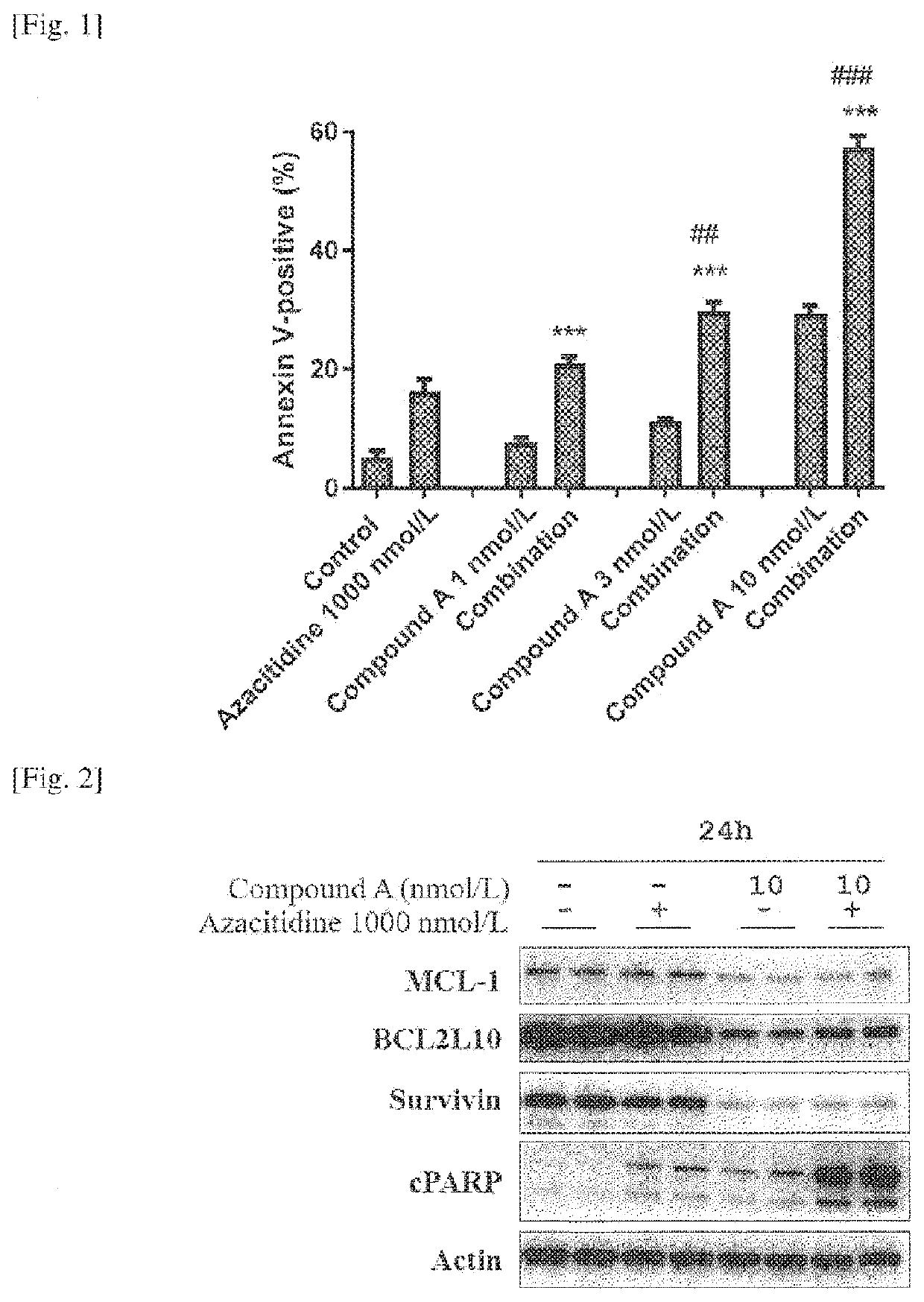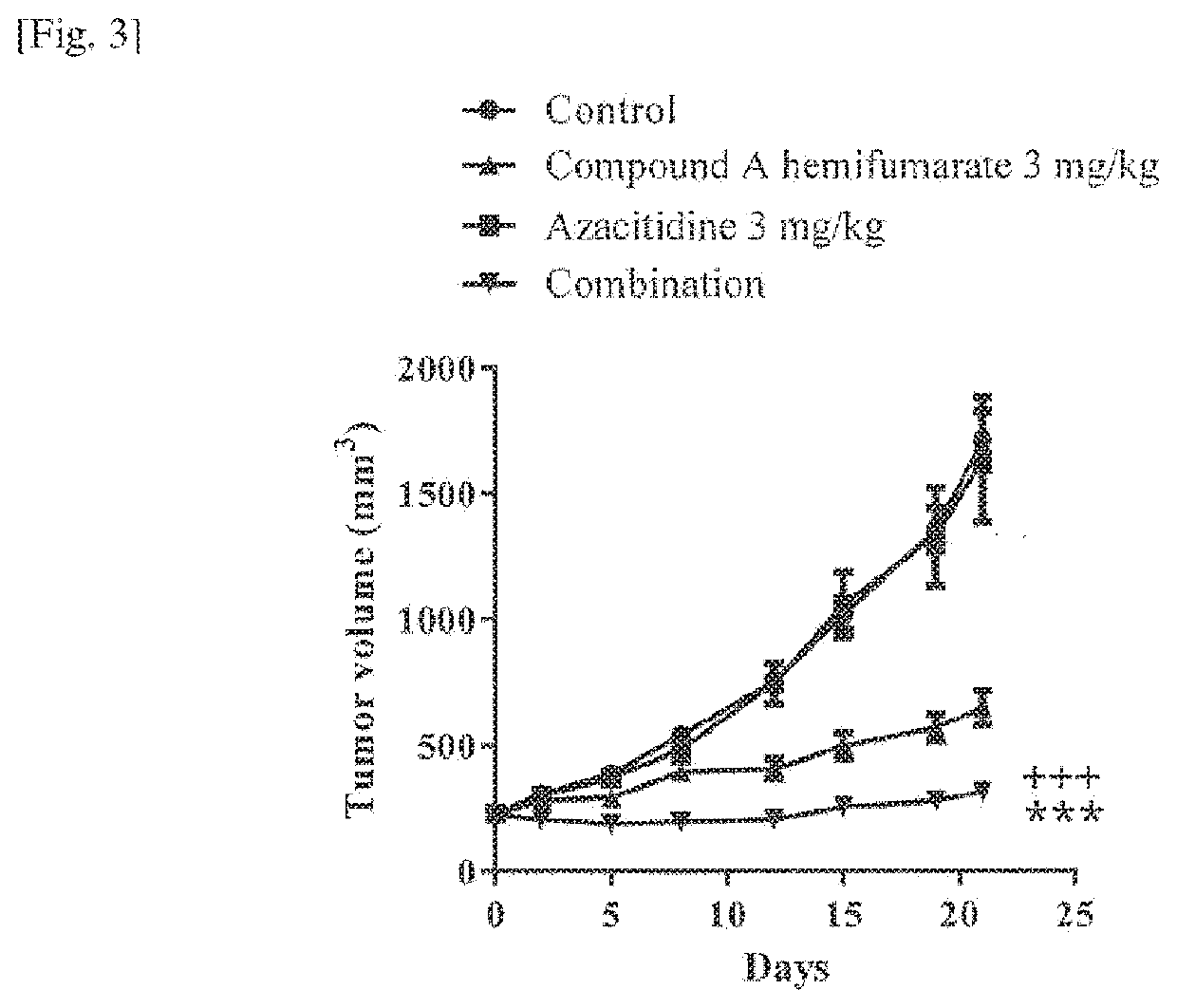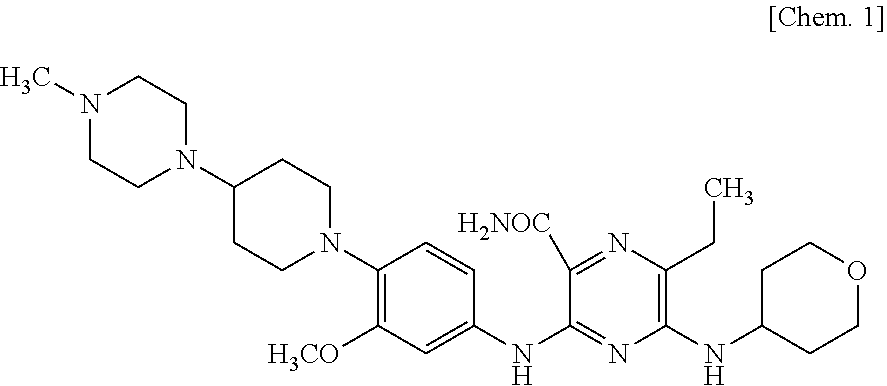Combination therapy for the treatment of acute myeloid leukemia
a combination therapy and myeloid leukemia technology, applied in the direction of antineoplastic agents, medical preparations, pharmaceutical delivery mechanisms, etc., can solve the problems of poor outcome, 40% to 55%, cr rate,
- Summary
- Abstract
- Description
- Claims
- Application Information
AI Technical Summary
Benefits of technology
Problems solved by technology
Method used
Image
Examples
example 1
[0079]Induced Apoptosis in MV4-11 Cells
[0080]MV4-11, a cell line derived from human AML and which harbors the FLT-3-ITD mutation, was purchased from American Type Culture Collection (ATCC). The cells were cultured at 37° C. in 5% CO2 in Iscove's Modified Dulbecco's Medium supplemented with 10% heat-inactivated fetal bovine serum. The cells were seeded on 12 well plates and were cultured overnight. The cells were treated with compound A at final concentrations of 0 (DMSO), 1,3 or 10 nmol / L in combination with azacitidine (Tokyo Chemical Industry) at final concentrations of 0 (DMSO) or 1000 nmol / L. After forty-eight hours, cells were harvested and incubated with Guava (registration symbol) Nexin Reagent (Merck Millipore), and annexin-V-positive cells were determined using a Guava (registration symbol) PCA microcytometer (Guava Technologies). The percentage of annexin-V-positive cells in each sample was analyzed using CytoSoft software (Guava Technologies). Mean and standard error (SE)...
example 2
[0083]Anti-Apoptosis Protein Expression
[0084]MV4-11 cells were seeded on 15 cm dish and cultured overnight. The cells were treated with compound A at 0 (DMSO) or 10 nmol / L in combination with azacitidine at 0 (DMSO) or 1000 nmol / L at final concentration. The assay was performed in duplicate. After twenty-four hours, cells were harvested and lysed with lysis buffer (RIPA Buffer [Thermo Fisher Scientific], 1×Halt Phosphatase Inhibitor Cocktail [Thermo Fisher Scientific], and Protease Inhibitor Cocktail [Sigma-Aldrich]). The samples are centrifuged, and protein concentrations of supernatants were determined using the Pierce (trademark) 660 nm Protein Assay (Thermo Fisher Scientific). Aliquots of 2.0 μg protein / μL were prepared in sample buffer (10 mmol / L dithiothreitol (DTT) [Nacalai Tesque] and 1×SDS sample buffer [Wako Pure Chemical Industries, Ltd.], in lysis buffer), and then were boiled for 5 min.
[0085]The samples were separated by electrophoresis and transferred with Trans-Blot (...
example 3
[0087]MV4-11 Xenografted Mouse Model
[0088]Four-week-old male nude mice {CAnN.Cg-Foxn1nu / CrlCrlj(nu / nu)} were purchased from Charles River Laboratories Japan, Inc., MV4-11 cells were subcutaneously inoculated into the flank at 5×106 cells / 0.1 mL / mouse and allowed to grow. Mice with tumor volumes (length×width2×0.5) of 100 to 300 mm3 were selected one day before administration and divided into 4 groups (n=10), so that the mean tumor volume in each group was almost equal. Control group received once-daily oral administration of 0.5% methylcellulose solution from Days 0 to 20, and once-daily intravenous administration of saline from Days 0 to 4. The compound A hemifumarate group received once-daily oral administration of compound A hemifumarate at 3 mg / kg / day from Days 0 to 20, and once-daily intravenous administration of saline from Days 0 to 4. The azacitidine group received once-daily oral administration of 0.5% methylcellulose from Days 0 to 20, and once-daily intravenous administra...
PUM
| Property | Measurement | Unit |
|---|---|---|
| time | aaaaa | aaaaa |
| time | aaaaa | aaaaa |
| time | aaaaa | aaaaa |
Abstract
Description
Claims
Application Information
 Login to View More
Login to View More - R&D
- Intellectual Property
- Life Sciences
- Materials
- Tech Scout
- Unparalleled Data Quality
- Higher Quality Content
- 60% Fewer Hallucinations
Browse by: Latest US Patents, China's latest patents, Technical Efficacy Thesaurus, Application Domain, Technology Topic, Popular Technical Reports.
© 2025 PatSnap. All rights reserved.Legal|Privacy policy|Modern Slavery Act Transparency Statement|Sitemap|About US| Contact US: help@patsnap.com



